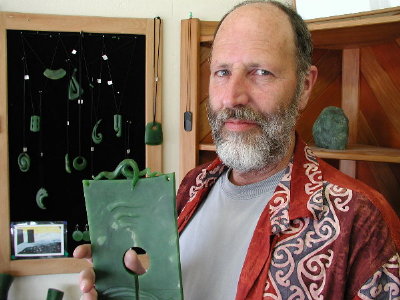
A month ago, we met James the Gardener. Today, we introduce you to another Waiheke resident, a local artist who creates and sells his works at a main street studio/shop called Jade Jade Jade. The shop is always busy. And his pieces are so distinctive that wearing one turns out to be a great way to meet people on the island.
Interview: Bob the Artist
Q: Every time I come into your shop, there are new pieces. How many do you make?
A: I make about six big pieces—that can each take up to a month—each year. Then I make about five smaller items each week, plus an occasional quite small and cheap—for the marketplace.
Q: Most of the smaller pieces are pendants that people wear; do you think of them as jewelry?
A: No, they’re little sculptures. They’re ideas that hang. I’m not really interested in decoration, and don’t really understand the world of jewelry.
Q: I’ve noticed that a lot of people in New Zealand wear jade. Why?
A: Mostly because of the Maoris, our native people, and their traditional use of it. To them, jade is the most valuable treasure. It’s the touchstone for their ancestors, and embodies the manna of their people.
Q: Is that true elsewhere? Or with any other stone?
A: It’s more true with jade than any other stone. And it happens in China, Europe, and Central America.
Q: What do you think makes jade so extraordinary?
A: It’s so durable they made axes with it in Neolithic times. And time has made it special. Jade is metamorphic, and goes through transformations you can see. There’s a story and history in each rock; it’s slow, fast, pure, and corrupt.
Q: How do you create your pieces?
A: Sometimes I start with an idea and sometimes the idea finds me. Each rock determines it, really. I have to find the story. It’s always a challenge. And the finished product is never as good as the primary idea.
Q: Is there a particular type of person who buys or wears jade?
A: Not at all. Even businessmen in Auckland wear them under their suits. It has nothing to do with their culture, wealth, or age.
Q: What do you think it means to people?
A: People wear it as a talisman. It’s a token of one’s connection with the earth, and of a migratory, nomadic people.
Q: What do you mean?
A: New Zealand was last place on earth to be colonized—the end of the line. When you live here, that imbues your sensibility. Jade is a way of finding commonality with our people back to the first Polynesians.
Q: How does that affect the forms you make?
A: Jade carving is the quintessential art of expressing that. I seek dynamic forms—curvilinear, infinite, open, and not tied down.
Q: Do you think your customers understand that?
A: I think so. I insist that the buyer knows what I was intending. That sounds egocentric, and I don’t mean it that way. Most people respond to the pieces and can’t even articulate why. But something touches them and they open up.
Q: Is that one of the perks of your job?
A: Very much so. I get to see what rhythms move people. It’s not immediate; it’s a spiritual thing—in the hearts of the people.
Q: Which gets back to jade helping people find a connection with the earth?
A: Yes. On the surface, it’s part of an environmental movement here. But I think it runs deeper. It’s part of our essence, and it’s coming back after fading for a while due to pressure from the American culture.
Q: What do you think might be the essence of American culture?
A: America is full of hope, always has been. But unfortunately, the way that’s presented now is materialistic hope.
Q: How do you stay inspired to do this every day?
A: If I’m going to spend a day or two on one piece, I need an idea—a good one. This is my way of reverence, of praying. What I do is quite monkish, really. So my body looks after itself, and I almost never lose interest or get tired.
Q: Have you always lived on Waiheke?
A: No, I was brought on across the way on the mainland. On the beach, really. Waiheke was on the horizon—where the moon came up.
Q: So how’d you end up here?
A: I’d been living and working in the city. The jobs weren’t working out, including one at the City Art Gallery. I couldn’t subject my children to the corruption and pretension of that world. So we came here.
Q: The art world was not for you?
A: Not at all. After I left, I didn’t visit a gallery or pick up an art book for 25 years. I do now. But I still have a distaste for the arty-farty world.
Q: Is this a better place to raise children?
A: Oh, yes. There is an enormous wonder throughout your life when your childhood is close to nature. I can’t imagine the emotional loss for children brought up in an apartment.
Q: And how’d you end up doing jade?
A: I had studied some sculpture, years ago. But when someone gave me some jade, I didn’t have to learn. I was making pieces within six weeks. I think I’d been waiting a long time.
Q: And I’ve kept you from your work for a long time. Thanks for sharing.
A: My pleasure. Enjoy your jade.
Tags: